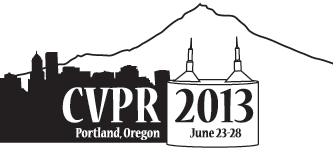-
Representing and Discovering Adversarial Team Behaviors Using Player Roles
AbstractIn this paper, we describe a method to represent and discover adversarial group behavior in a continuous domain. In comparison to other types of behavior, adversarial behavior is heavily structured as the location of a player (or agent) is dependent both on their teammates and adversaries, in addition to the tactics or strategies of the team. We present a method which can exploit this relationship through the use of a spatiotemporal basis model. As players constantly change roles during a match, we show that employing a "role-based" representation instead of one based on player "identity" can best exploit the playing structure. As vision-based systems currently do not provide perfect detection/tracking (e.g. missed or false detections), we show that our compact representation can effectively "denoise" erroneous detections as well as enabling temporal analysis, which was previously prohibitive due to the dimensionality of the signal. To evaluate our approach, we used a fully instrumented field-hockey pitch with 8 fixed highdefinition (HD) cameras and evaluated our approach on approximately 200,000 frames of data from a state-of-theart real-time player detector and compare it to manually labelled data.
Related Material
[pdf][bibtex]@InProceedings{Lucey_2013_CVPR,
author = {Lucey, Patrick and Bialkowski, Alina and Carr, Peter and Morgan, Stuart and Matthews, Iain and Sheikh, Yaser},
title = {Representing and Discovering Adversarial Team Behaviors Using Player Roles},
booktitle = {Proceedings of the IEEE Conference on Computer Vision and Pattern Recognition (CVPR)},
month = {June},
year = {2013}
}
These CVPR 2013 papers are the Open Access versions, provided by the Computer Vision Foundation.
Except for the watermark, they are identical to the accepted versions; the final published version of the proceedings is available on IEEE Xplore.
Except for the watermark, they are identical to the accepted versions; the final published version of the proceedings is available on IEEE Xplore.
This material is presented to ensure timely dissemination of scholarly and technical work.
Copyright and all rights therein are retained by authors or by other copyright holders.
All persons copying this information are expected to adhere to the terms and constraints invoked by each author's copyright.

